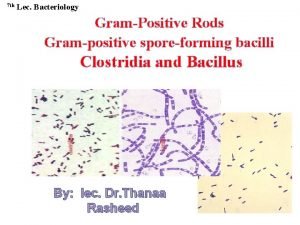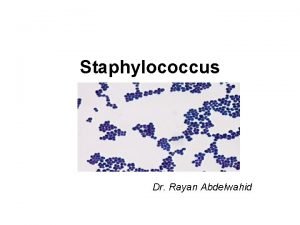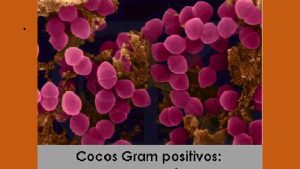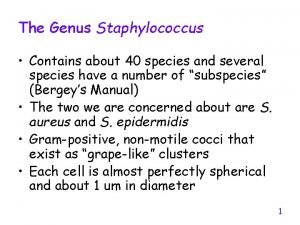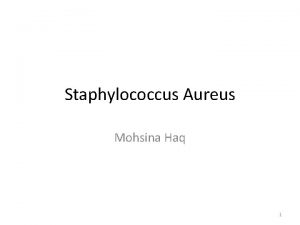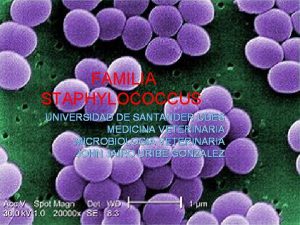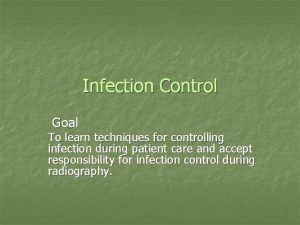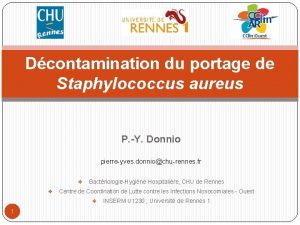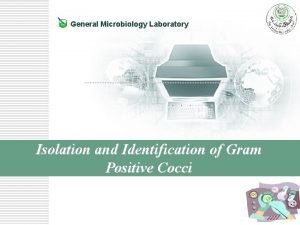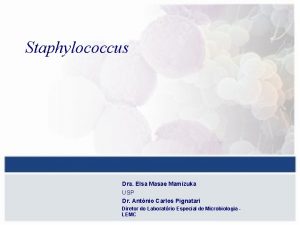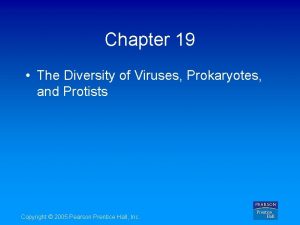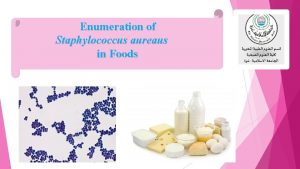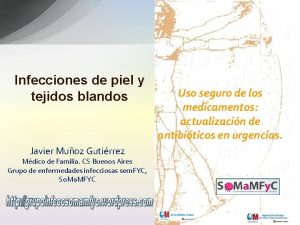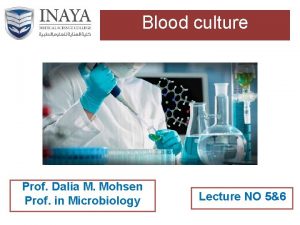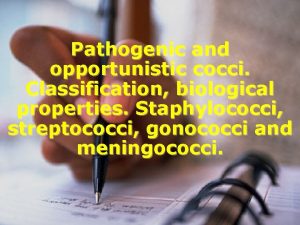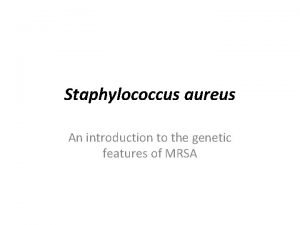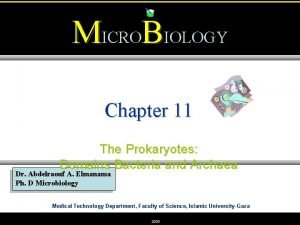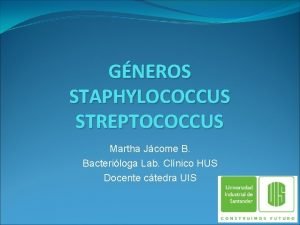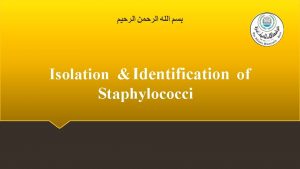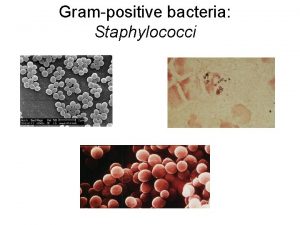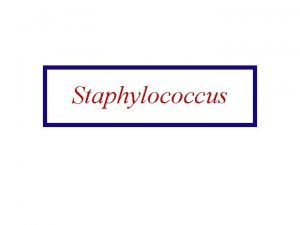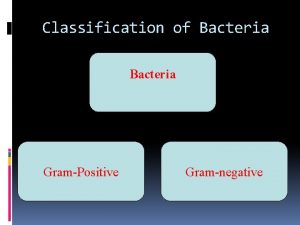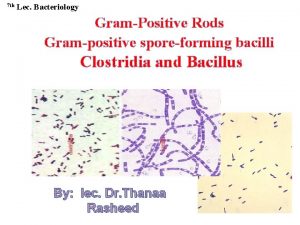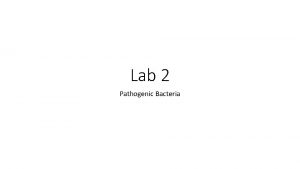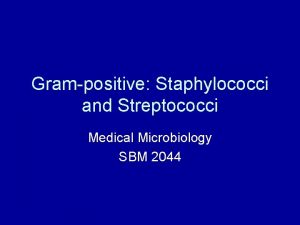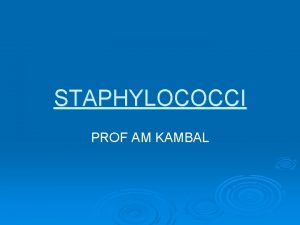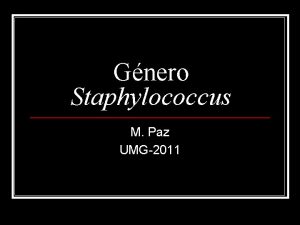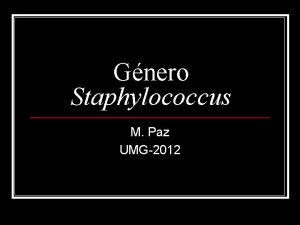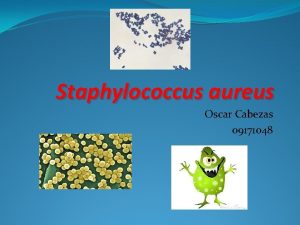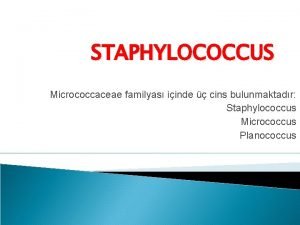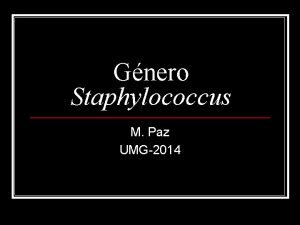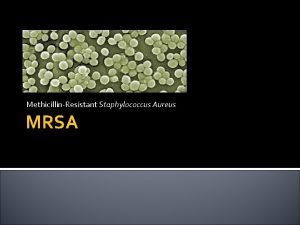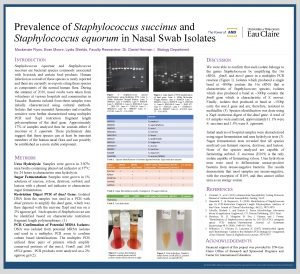Ex Staphylococcus The Staphylococci Staphylococci are Grampositive spherical





























- Slides: 29

Ex. , Staphylococcus

The Staphylococci • Staphylococci are Gram-positive spherical bacteria that occur in clusters resembling grapes. • They grow in clusters because staphylococci divide in two planes. The configuration of the cocci helps to distinguish staphylococci from streptococci, which are slightly oblong cells that usually grow in chains (because they divide in one plane only). • The catalase test is important in distinguishing streptococci (catalase-negative) from staphylococci, which are vigorous catalase-producers. • Two pigmented colony types. • Staphylococcus aureus (yellow) • Staphylococcus albus (white) or Staphylococcus epidermidis. • Only Staphylococcus aureus and Staphylococcus epidermidis are significant in their interactions with humans.

The important phenotypic characteristics of Staphylococcus aureus • Gram-positive, cluster-forming coccus • nonmotile, nonsporeforming facultative anaerobe • fermentation of glucose produces mainly lactic acid ferments mannitol (distinguishes from S. epidermidis) • catalase positive • coagulase positive • golden yellow colony on agar • normal flora of humans found on nasal passages, skin and mucous membranes • pathogen of humans, causes a wide range of suppurative infections, as well as food poisoning and toxic shock syndrome

Pathogenesis of S. aureus infections • It causes superficial skin lesions such as boils, styes and furunculosis; more serious infections such as pneumonia, mastitis, phlebitis, meningitis, and urinary tract infections; • Deep-seated infections, such as osteomyelitis and endocarditis. S. aureus is a major cause of hospital acquired (nosocomial) infection of surgical wounds and infections associated with indwelling medical devices. • S. aureus causes food poisoning by releasing enterotoxins into food, and toxic shock syndrome by release of superantigens into the blood stream.


Virulence factors of S. aureus • (1) surface proteins that promote colonization of host tissues. • (2) Invasions that promote bacterial spread in tissues (leukocidin, kinases). • (3) Surface factors that inhibit phagocytic engulfment (capsule, Protein A). • (4) Biochemical properties that enhance their survival in phagocytes (carotenoids, catalase production).

• (5) Immunological disguises (Protein A, coagulase, clotting factor). • (6) Membrane-damaging toxins that lyse eukaryotic cell membranes (hemolysins, leukotoxin, leukocidin). • (7) Exotoxins that damage host tissues or otherwise provoke symptoms of disease. • (8) Inherent and acquired resistance to antimicrobial agents.

• Human staphylococcal infections are frequent, but usually remain localized at the portal of entry by the normal host defenses. • The portal may be a hair follicle, but usually it is a break in the skin which may be a minute needle-stick or a surgical wound. • Another portal of entry is the respiratory tract. Staphylococcal pneumonia is a frequent complication of influenza.

• The localized host response to staphylococcal infection is inflammation, characterized by an elevated temperature at the site, swelling, the accumulation of pus, and necrosis of tissue. • Around the inflamed area, a fibrin clot may form, walling off the bacteria and leukocytes as a characteristic pus-filled boil or abscess. • More serious infections of the skin may occur, such as furuncles or impetigo. Localized infection of the bone is called osteomyelitis.

• Serious consequences of staphylococcal infections occur when the bacteria invade the blood stream. • A resulting septicemia may be rapidly fatal; a bacteremia may result in seeding other internal abscesses, other skin lesions, or infections in the lung, kidney, heart, skeletal muscle or meninges.

• Infection Process

Adherence to Host Cell Proteins • S. aureus cells express on their surface proteins that promote attachment to host proteins such as laminin and fibronectin that form the extracellular matrix of epithelial and endothelial surfaces. • In addition, most strains express a fibrin/fibrinogen binding protein (clumping factor) which promotes attachment to blood clots and traumatized tissue. • Most strains of S. aureus express both fibronectin and fibrinogen-binding proteins. In addition, an adhesin that promotes attachment to collagen has been found in strains that cause osteomyelitis and septic arthritis.

Invasion • The invasion of host tissues by staphylococci apparently involves the production of a huge array of extracellular proteins, some of which may occur also as cell-associated proteins. • These proteins are described below with some possible explanations for their role in invasive process.

Membrane-damaging toxins • a-toxin (a-hemolysin) • The best characterized and most potent membrane-damaging toxin. • It is expressed as a monomer that binds to the membrane of susceptible cells. • In humans, platelets and monocytes are particularly sensitive to a-toxin. Susceptible cells have a specific receptor for atoxin which allows the toxin to bind causing small pores through which monovalent cations can pass. The mode of action of alpha hemolysin is likely by osmotic lysis.

ß-toxin • Is a sphingomyelinase which damages membranes rich in this lipid.

d-toxin • Is a very small peptide toxin produced by most strains of S. aureus. • It is also produced by S. epidermidis. • The role of d-toxin in disease is unknown.

Leukocidin • Is separated protein toxins which act together to damage membranes. • Leukocidin is hemolytic, but less so than alpha hemolysin. • Important factor in necrotizing skin infections.

Coagulase and clumping factor • Coagulase is an extracellular protein prothrombin in the host to form a staphylothrombin. The protease activity thrombin is activated in the complex, conversion of fibrinogen to fibrin. which binds to complex called characteristic of resulting in the • Coagulase is a traditional marker for identifying S aureus in the clinical microbiology laboratory. However, there is no evidence that it is a virulence factor, although it is reasonable to speculate that the bacteria could protect themselves from phagocytic and immune defenses by causing localized clotting.

• There is some confusion in the literature concerning coagulase and clumping factor, the fibrinogenbinding determinant on the S. aureus cell surface. • Partly the confusion results from the fact that a small amount of coagulase is tightly bound on the bacterial cell surface where it can react with prothrombin leading to fibrin clotting. However, genetic studies have shown unequivocally that coagulase and clumping factor are distinct entities. • Specific mutants lacking coagulase retain clumping factor activity, while clumping factor mutants express coagulase normally.

Staphylokinase • Many strains of S aureus express a plasminogen activator called staphylokinase. This factor lyses fibrin. The genetic determinant is associated with lysogenic bacteriophages. • A complex formed between staphylokinase and plasminogen activates plasmin-like proteolytic activity which causes dissolution of fibrin clots.

• The mechanism is identical to streptokinase, which is used in medicine to treat patients suffering from coronary thrombosis. As with coagulase, there is no strong evidence that staphylokinase is a virulence factor, although it seems reasonable to imagine that localized fibrinolysis might aid in bacterial spreading.

Other extracellular enzymes • S. aureus can express proteases, a lipase, a deoxyribonuclease (DNase) and a fatty acid modifying enzyme (FAME). • However, the FAME enzyme may be important in abscesses, where it could modify antibacterial lipids and prolong bacterial survival.

Avoidance of Host Defenses • S. aureus expresses a number of factors that have the potential to interfere with host defense mechanisms. This includes both structural and soluble elements of the bacterium.

Capsular Polysaccharide • The majority of clinical isolates of S aureus expresses a surface polysaccharide but rapidly lose the ability when cultured in the laboratory. • This has been called a microcapsule because it can be visualized only by electron microscopy. • The function of the capsule in virulence is not entirely clear. Although it does impede phagocytosis, it also impedes colonization of damaged heart valves, perhaps by masking adhesins.

Protein A • Protein A is a surface protein of S. aureus which binds Ig. G molecules (in serum) in the wrong orientation on their surface which disrupts opsonization and phagocytosis.

Exotoxins • S. aureus can express several different types of protein toxins which are probably responsible for symptoms during infections.

• Some will lyse erythrocytes, causing hemolysis. • Leukocidin causes membrane damage to leukocytes. • Systemic release of a-toxin causes septic shock. • Staphylococcal enterotoxins cause emesis (vomiting) when ingested and the bacterium is a leading cause of food poisoning.

Host Defense against Staphylococcal Infections • Phagocytosis is the major mechanism for combatting staphylococcal infection. Antibodies are produced which neutralize toxins and promote opsonization. • However, the bacterial capsule and protein A may interfere with phagocytosis.

• Staphylococci may be difficult to kill after phagocytic engulfment because they produce carotenoids and catalase which neutralize singlet oxygen and superoxide which are primary phagocytic killing mechanisms within the phagolysosome.
 Insidan region jh
Insidan region jh Grampositive rods
Grampositive rods Staphylococcus shape
Staphylococcus shape Coagulase negative staphylococcus
Coagulase negative staphylococcus Escaldada estafilocócica
Escaldada estafilocócica Teukoka
Teukoka Classification of staphylococcus
Classification of staphylococcus Streptococcus pneumoniae morphology
Streptococcus pneumoniae morphology Staphylococcus coagulazo-pozitiv
Staphylococcus coagulazo-pozitiv Which organisms are prokaryotes
Which organisms are prokaryotes Staphylococcus aureus cocci or bacilli
Staphylococcus aureus cocci or bacilli Staphylococcus aureus
Staphylococcus aureus Staphylococcus aureus?
Staphylococcus aureus? Portage staphylococcus aureus
Portage staphylococcus aureus Mannitol fermenter
Mannitol fermenter Oxaclina
Oxaclina Staphylococcus prokaryotic or eukaryotic
Staphylococcus prokaryotic or eukaryotic Transduktion
Transduktion Staphylococcus aureus confirmation test
Staphylococcus aureus confirmation test Staphylococcus aureus
Staphylococcus aureus Tmp smx dosis pediatrica
Tmp smx dosis pediatrica Staphylococcus
Staphylococcus Staphylococcus
Staphylococcus Micrococcaceae family
Micrococcaceae family Enzymes of staphylococcus aureus
Enzymes of staphylococcus aureus Enzymes of staphylococcus aureus
Enzymes of staphylococcus aureus Etiolgia
Etiolgia Staphylococcus
Staphylococcus Conjugation reproduction
Conjugation reproduction Staphylococcus saprophyticus patogenia
Staphylococcus saprophyticus patogenia

